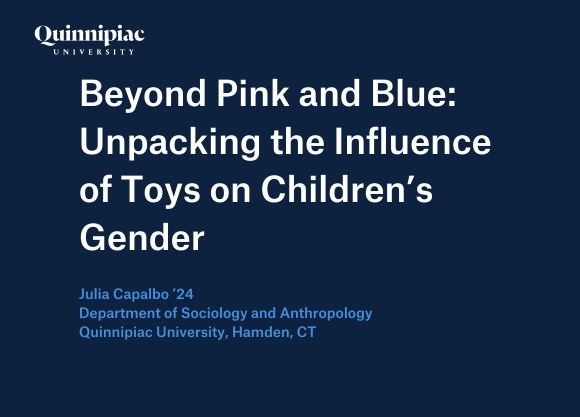Sociology
Unpacking the Influence of Toys on Children’s Gender

Sociology
Unpacking the Influence of Toys on Children’s Gender
This study aims to investigate how children's gender views are influenced by toys. Unlike previous studies, it investigates the psychological processes affecting children's gender perceptions while they interact with toys.
Overview
This study looks more closely at the effects of toys on kids' behavior and psychological development. By investigating how toys influence children's play patterns, interpersonal interactions, and cognitive development, the research seeks to understand the basic mechanisms influencing children's preferences for gendered toys and their self-concept.
Author

Julia Capalbo '24
Sociology
College of Arts & Sciences
Beyond Pink and Blue: Unpacking the Influence of Toys on Children’s Gender
Project Summary
The focus of this study is to look into how toys affect children's gender perceptions. In contrast to earlier research, it explores the psychological mechanisms influencing kids' perceptions of gender while they engage with toys. The impact of toys on children's behavior and psychological development is further investigated in this study. The research aims to explore the fundamental mechanisms impacting children's preferences for gendered toys and their self-concept by exploring how toys shape children's play habits, relationships, and cognitive development.
In order to clarify the impact of media, friends, and family dynamics on forming children's preferences on toys, this study will investigate these questions through participant observation and interviews into the social elements influencing children's toy selections. To what degree children's toy selections mirror larger society patterns is the purpose of this research, which looks at how cultural norms and societal expectations affect gender-stereotypical toys.
This research will contribute to the goal of "Let Toys Be Toys" by shedding light on how toys affect kids' behavior and growth. The results will guide advocacy campaigns for inclusive toy selections, giving parents and legislators the tools they need to combat gender stereotypes in the toy business and advance play fairness for any child.
Project Narrative
Gendered toy marketing plays a substantial role in shaping children's preferences and perceptions of gender roles from a remarkably young age. The existing body of research underscores the necessity for more comprehensive exploration into the mechanisms through which gender stereotypes are perpetuated within toy commercials. These marketing strategies wield considerable influence, as they not only reinforce established gender norms but also contribute to the development of children's play habits and toy preferences. Even when presented with gender-neutral toy options, studies indicate that children still tend to associate specific toys with the gender categories they belong to, highlighting the pervasive impact of social indicators and advertisements on their choices.
Social factors exert significant influence on children's toy preferences, encompassing a wide array of influences ranging from media portrayals to familial and peer interactions. Researchers aim to gain a deeper understanding of how these factors, including media exposure, peer interactions, familial dynamics, and classroom environments, collectively shape children's perceptions of gender-stereotypical toys. By examining the extent to which children's toy preferences mirror broader societal patterns, scholars seek insights into the ways in which these preferences either uphold or challenge conventional gender norms.
The influence of toys extends beyond mere playtime, significantly impacting various aspects of children's development, including their cognitive processes, social interactions, and self-concept. Investigating the intricate relationship between toys and children's behavior, researchers explore how toys shape children's understanding and expression of gender identity. Given the profound influence of toys on children's development, interventions aimed at fostering more inclusive play experiences are paramount. By challenging traditional gender stereotypes embedded within toy design, marketing, and messaging, these interventions strive to create environments that encourage cognitive growth, socialization, and positive self-expression among children, ultimately promoting more equitable and diverse representations of gender in play.
Research Plan
The primary topic of this study's research question is how do toys affect children’s perception of gender? The study’s dependent variable is children’s perception on gender and the key independent variable is children’s toys. The main methods of this study will be observations and interviews to look into how toys affect kids' gender perceptions. While observations will take place in a variety of contexts, such as playrooms, and classrooms, interviews will involve a varied sample of parents, caregivers, educators, and children. Research frequently ignores the notion that a closer knowledge of children's opinions and experiences with gendered toys can be achieved by prioritizing direct connection with the young audience. If needed, surveys might also be used.
For the ethnographic component of the study, observations will be conducted in playrooms and classrooms. This will involve spending designated periods of time each week over the course of the research period to observe and interview children's interactions with boys and girls toys. For the interviews, the main focus will be on children, parents, and educators. Probability sampling will be employed, ensuring that each child, parent, caregiver, and educator in the larger population has a known probability of being selected, ensuring that the sample accurately represents the population and reduces the likelihood of bias or underrepresentation.
The information gathered from interviews and observational studies will be subjected to qualitative methods in order to find trends and themes pertaining to kids' attitudes and actions around gendered play toys
Timeline
- Phase I (September 2024 - October 2024): Conduct and complete interviews and observations in playrooms and classrooms in Nassau County, Long Island, New York.
- Phase II (November 2024 - December 2024): Conduct and complete interviews and observations in playrooms and classrooms in Suffolk County, Long Island, New York.
- Phase III (January 2025): Finalize data collection and transcription of interviews from both Nassau and Suffolk Counties.
- Phase IV (February 2025): Begin preliminary data analysis of transcribed interviews.
- Phase V (March 2025): Continue data analysis and synthesis of findings from observations interviews.
Existing Resources and Equipment
Let Toys Be Toys advocates for the end of gender-specific toy marketing and labeling that children see and encourages children to be able to play with all toys. Let Toys Be Toys works with a range of people, such as children, parents, educators, and toy companies, to encourage inclusivity in play experiences and combat gender stereotypes.
Julia Capalbo will be the primary investigator for the study. Julia is a sociology major with a psychology minor enrolled at Quinnipiac University, where sociology students are conducting a grant proposal as part of their final project. Julia is qualified to conduct this research because of her coursework and previous experience in learning about research methods. Julia also has guidance from Grace Yukich, professor of sociology at Quinnipiac University, who has research experience and is her professor in her current course.
Professional Application
“This prepares me for my career by wanting to go into research analysis for pharmaceutical companies. My grant proposal made me intrigued to continue research. This worthwhile experience not only fits with my goals for a career in pharmaceutical research analysis, but it also marks a significant turning point in my development as a professional. Working on my grant proposal has improved my writing abilities and sparked a deep interest and passion for study. It has strengthened my resolve to strive for greatness in scientific research while also giving me a better grasp of the complexities and difficulties present in this discipline. In addition, the chance to explore the complexities of writing a proposal has encouraged a feeling of accountability and duty to advance knowledge and innovation in pharmaceutical research.” – Julia Capalbo ’24
For Further Discussion
This serves as an overview of the project and does not include the complete work. To further discuss this project, please email Julia Capalbo.
Course Overview
SO 400: Senior Seminar is designed as the capstone course for students majoring in sociology and gerontology. Students research a sociological or aging-related topic of their choosing and write a thesis based on their work. All senior theses represent a culmination of majors' academic experiences in the department.
Explore Our Areas of Interest
We've sorted each of our undergraduate, graduate and doctoral programs into unique Areas of Interest. Explore these categories to discover which programs and delivery methods best align with your educational and career goals.
